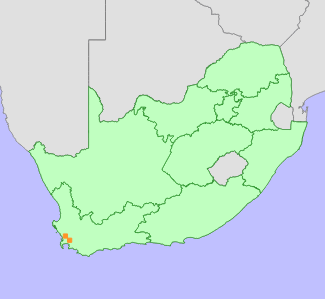|
Scientific Name | Aspalathus crewiana Boatwr. & Cupido |
Higher Classification | Dicotyledons |
Family | FABACEAE |
National Status |
Status and Criteria | Critically Endangered B1ab(iii,v)+2ab(iii,v) |
Assessment Date | 2012/05/14 |
Assessor(s) | J.S. Boatwright & L. von Staden |
Justification | EOO 11 km², AOO 0.42 km², two small, severely fragmented remaining subpopulations continue to decline due to ongoing habitat loss and degradation. |
Distribution |
Endemism | South African endemic |
Provincial distribution | Western Cape |
Range | Klipheuwel to Klapmuts. |
Habitat and Ecology |
Major system | Terrestrial |
Major habitats | Swartland Shale Renosterveld, Swartland Alluvium Fynbos |
Description | Seasonally waterlogged shale and granite derived clay soils. |
Threats |
| More than 90% of this species' lowland renosterveld habitat is already transformed, predominantly for crop cultivation, and only small fragments remain. At one location the natural vegetation is disturbed and severely degraded due to alien plant infestations and a lack of fire. The second location, although a protected area, is invaded by alien grasses which are particularly difficult to control, and is also susceptible to eutrophication, pesticide and herbicide runoff from surrounding farms. |
Population |
Two subpopulations remain on two small fragments of a few hectares each, about 15 km apart. Very few plants are present at both locations but this may be due to both sites not being burnt in a very long time at the time of surveys. Most Aspalathus species are most abundant in the first few years after fire, but decline in mature vegetation. Aspalathus crewiana's biology is not yet well known and its response to fire needs to be determined. There is very little of this species' habitat left and most other fragments in the area have been repeatedly and thoroughly surveyed by volunteers of the Custodians of Rare and Endangered Wildflowers (CREW), and it is very unlikely that other subpopulations remain. Plants at one location continue to decline due to ongoing degradation of the site, while the second subpopulation is protected in a very small, but well managed provincial nature reserve.
|
Population trend | Decreasing |
Assessment History |
Taxon assessed |
Status and Criteria |
Citation/Red List version | | Aspalathus crewiana Boatwr. & Cupido | CR B1ab(iii,v)+2ab(iii,v) | 2012.1 | |
Bibliography |
Boatwright, J.S. and Cupido, C.N. 2011. Aspalathus crewiana sp. nov. (Crotalarieae, Fabaceae) from the Western Cape Province, South Africa. Nordic Journal of Botany 29(5):513-517.
|
Citation |
| Boatwright, J.S. & von Staden, L. 2012. Aspalathus crewiana Boatwr. & Cupido. National Assessment: Red List of South African Plants version 2024.1. Accessed on 2025/10/26 |
 Comment on this assessment
Comment on this assessment


